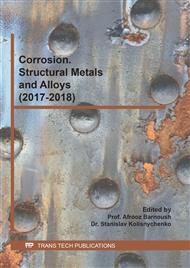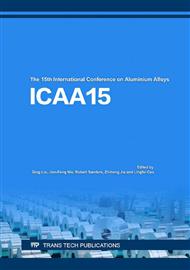[1]
J.C. Williams, E.A. Starke, Progress in structural materials for aerospace systems, Acta Mater., 51 (2003) 5775–5799.
Google Scholar
[2]
H.E. Hu, L. Zhen, L. Yang, W.Z. Shao, B.Y. Zhang, Deformation behavior and microstructure evolution of 7050 aluminum alloy during high temperature deformation, Mater. Sci. Eng. A, 488(2008)64–71.
DOI: 10.1016/j.msea.2007.10.051
Google Scholar
[3]
J.F. Li, Z.W. Peng, C.X. Li, Z.Q. Jia, W.J. Chen, Z.Q. Zheng, Mechanical properties, corrosion behaviors and microstructures of 7075 aluminium alloy with various aging treatments, Trans. Nonferrous Met. Soc. China, 18(4)(2008)755–762.
DOI: 10.1016/s1003-6326(08)60130-2
Google Scholar
[4]
J.K. Park, Influence of retrogression and reaging treatments on the strength and stress corrosion resistance of aluminium alloy 7075-T6Influence of retrogression and reaging treatments on the strength and stress corrosion resistance of aluminium alloy 7075-T6, Influence of retrogression and reaging treatments on the strength and stress corrosion resistance of aluminium alloy 7075-T6Influence of retrogression and reaging treatments on the strength and stress corrosion resistance of aluminium alloy 7075-T6Influence of retrogression and reaging treatments on the strength and stress corrosion resistance of aluminium alloy 7075-T6Mater. Sci. Eng. A, 103(88)(1988).
DOI: 10.1016/0025-5416(88)90512-5
Google Scholar
[5]
G.F. Li, X.M. Zhang, P.H. Li, J.H. You, Effects of retrogression heating rate on microstructures and mechanical properties of aluminum alloy 7050, Trans. Nonferrous Met. Soc. China, 20(2010)935–941.
DOI: 10.1016/s1003-6326(09)60239-9
Google Scholar
[6]
I. Westermanna, O.S. Hopperstada, K.I. Marthinsenb, B. Holmedal, Ageing and work-hardening behaviour of a commercial AA7108 aluminium alloy, Mater. Sci. Eng. A, 524(2009)151–157.
DOI: 10.1016/j.msea.2009.06.036
Google Scholar
[7]
D. Dumont, A. Deschamps, Y. Brechet, On the relationship between microstructure, strength and toughness in AA7050 aluminum alloy, Mater. Sci. Eng. A, 356(1–2)(2003)326–336.
DOI: 10.1016/s0921-5093(03)00145-x
Google Scholar
[8]
M. Puiggali, A. Zielinski, J.M. Olive, E. Renauld, D. Desjardins, M. Cid, Effect of microstructure on stress corrosion cracking of an Al-Zn-Mg-Cu alloy, Corros. Sci., 40(4–5)(1998)805–819.
DOI: 10.1016/s0010-938x(98)00002-x
Google Scholar
[9]
T. Marlaud, B. Malki. C. Henon, A. Deschamps, B. Baroux, Relationship between alloy composition, microstructure and exfoliation corrosion in Al–Zn–Mg–Cu alloys, Corros. Sci., 53(2011)3139–3149.
DOI: 10.1016/j.corsci.2011.05.057
Google Scholar
[10]
Wang, Z.Y. Ma, Effect of pre-strain on microstructure and stress corrosion cracking of over-aged 7050 aluminum alloy, J. Alloys Compd., 469(2009)445–450.
DOI: 10.1016/j.jallcom.2008.01.137
Google Scholar
[11]
H.L. Liao, J.C. Lin, S.L. Lee, Effect of pre-immersion on the SCC of heat-treated AA7050 in an alkaline 3. 5%NaCl, Corros. Sci., 51(2)(2009)209–216.
DOI: 10.1016/j.corsci.2008.10.037
Google Scholar
[12]
M.E. Orazem, B. Tribollet, Electrochemical Impedance Spectroscopy , Wiley, New York, (2008).
Google Scholar
[13]
S.S. Wang, G.S. Frankel, J.T. Jiang, J.F. Chen, S.L. Dai, L. Zhen, Mechanism of localized breakdown of 7000 series aluminum alloys, J. Electrochem. Soc., 160(2013)493–502.
DOI: 10.1149/2.080310jes
Google Scholar
[14]
R.G. Buchheit, N. Birbilis, Electrochemical characteristics of intermetallic phases in aluminum alloys—An experimental survey and discussion, J. Electrochem. Soc., 152(2005)140–151.
DOI: 10.1149/1.1869984
Google Scholar
[15]
J.F. Chen, G.S. Frankel, J.T. Jiang, W.L. Shao, L. Zhen, Effect of age-forming on corrosion properties of an Al—Zn—Mg—Cu alloy, Mater. Corros., 65(2014)670-677.
DOI: 10.1002/maco.201206951
Google Scholar



